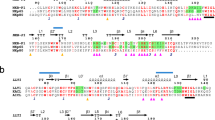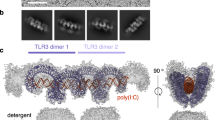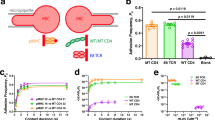Abstract
The major histocompatibility complex (MHC) class I homolog, MICA, is a stress-inducible ligand for NKG2D, a C-type lectin–like activating immunoreceptor. The crystal structure of this ligand-receptor complex that we report here reveals an NKG2D homodimer bound to a MICA monomer in an interaction that is analogous to that seen in T cell receptor–MHC class I protein complexes. Similar surfaces on each NKG2D monomer interact with different surfaces on either the α1 or α2 domains of MICA. The binding interactions are large in area and highly complementary. The central section of the α2-domain helix, disordered in the structure of MICA alone, is ordered in the complex and forms part of the NKG2D interface. The extensive flexibility of the interdomain linker of MICA is shown by its altered conformation when crystallized alone or in complex with NKG2D.
This is a preview of subscription content, access via your institution
Access options
Subscribe to this journal
Receive 12 print issues and online access
$209.00 per year
only $17.42 per issue
Buy this article
- Purchase on SpringerLink
- Instant access to full article PDF
Prices may be subject to local taxes which are calculated during checkout





Similar content being viewed by others
References
Germain, R. N. & Margulies, D. H. The biochemistry and cell biology of antigen processing and presentation. Ann. Rev. Immunol. 11, 403–450 (1993).
Lenschow, D. J., Walunas, T. L. & Bluestone, J. A. CD28/B7 system of T cell costimulation. Annu. Rev. Immunol. 14, 233–258 (1996).
Lanier, L. L. Turning on natural killer cells. J. Exp. Med. 191, 1259–1262 (2000).
Ravetch, J. V. & Lanier, L. L. Immune inhibitory receptors. Science 290, 84–89 (2000).
Lee, N. et al. HLA-E is a major ligand for the natural killer inhibitory receptor CD94/NKG2A. Proc. Natl Acad. Sci. USA 95, 5199–5204 (1998).
Weis, W. I., Taylor, M. E. & Drickamer, K. The C-type lectin superfamily in the immune system. Immunol. Rev. 163, 19–34 (1998).
Drickamer, K. Ca2+-dependent carbochydrate-recognition domains in animal proteins. Curr. Opin. Struct. Biol. 3, 393–400 (1993).
Lopez-Botet, M. & Bellon, T. Natural killer cell activation and inhibition by receptors for MHC class I. Curr. Opin. Immunol. 11, 301–307 (1999).
Fan, Q. R. et al. Structure of the inhibitory receptor for human natural killer cells resembles haematopoietic receptors. Nature 389, 96–100 (1997).
Snyder, G. A., Brooks, A. G. & Sun, P. D. Crystal structure of the HLA-Cw3 allotype-specific killer cell inhibitory receptor KIR2DL2. Proc. Natl Acad. Sci. USA 96, 3864–3869 (1999).
Maenaka, K., Juji, T., Stuart, D. I. & Jones, E. Y. Crystal structure of the human p58 killer cell inhibitory receptor (KIR2DL3) specific for HLA-Cw3-related MHC class I. Structure 7, 391–398 (1999).
Boyington, J. C., Motyka, S. A., Schuck, P., Brooks, A. G. & Sun, P. D. Crystal structure of an NK cell immunoglobulin-like receptor in complex with its class I MHC ligand. Nature 405, 537–543 (2000).
Boyington, J. C. et al. Structure of CD94 reveals a novel C-type lectin fold: implications for the NK cell-associated CD94/NKG2 receptors. Immunity 10, 75–82 (1999).
Tormo, J., Natarajan, K., Margulies, D. H. & Mariuzza, R. A. Crystal structure of a lectin-like natural killer cell receptor bound to its MHC class I ligand. Nature 402, 623–631 (1999).
Houchins, J. P., Yabe, T., McSherry, C. & Bach, F. H. DNA sequence analysis of NKG2, a family of related cDNA clones encoding type II integral membrane proteins on human natural killer cells. J. Exp. Med. 173, 1017–1020 (1991).
Bauer, S. et al. Activation of NK cells and T cells by NKG2D, a receptor for stress-inducible MICA. Science 285, 727–729 (1999).
Wu, J. et al. An activating immunoreceptor complex formed by NKG2D and DAP10. Science 285, 730–732 (1999).
Wu, J., Cherwinski, H., Spies, T., Phillips, J. H. & Lanier, L. L. DAP10 and DAP12 form distinct, but functionally cooperative, receptor complexes in natural killer cells. J. Exp. Med. 192, 1059–1067 (2000).
Bahram, S., Bresnahan, M., Geraghty, D. E. & Spies, T. A. A second lineage of mammalian major histocompatibility complex class I genes. Proc. Natl Acad. Sci. USA 91, 6259–6263 (1994).
Bahram, S. & Spies, T. A. Nucleotide sequence of a human MHC class I MICB cDNA. Immunogenetics 43, 230–233 (1996).
Groh, V. et al. Cell stress-regulated human major histocompatibility complex class I gene expressed in gastrointestinal epithelium. Proc. Natl Acad. Sci. USA 93, 12445–12450 (1996).
Groh, V., Steinle, A., Bauer, S. & Spies, T. Recognition of Stress-Induced MHC Molecules by Intestinal Epithelial γδ T Cells. Science 279, 1737–1740 (1998).
Groh, V. et al. Broad tumor-associated expression and recognition by tumor-derived γ δ T cells of MICA and MICB. Proc. Natl Acad. Sci. USA 96, 6879–6884 (1999).
Steinle, A., Groh, V. & Spies, T. Diversification, expression, and γ δ T cell recognition of evolutionarily distant members of the MIC family of major histocompatibility complex class I-related molecules. Proc. Natl Acad. Sci. USA 95, 12510–12515 (1998).
Li, P. et al. Crystal Structure of the MHC Class I Homolog MIC-A, a γδ T Cell Ligand. Immunity 10, 577–584 (1999).
Weis, W. I., Kahn, R., Fourme, R., Drickamer, K. & Hendrickson, W. A. Structure of the calcium-dependent lectin domain from a rat mannose-binding protein determined by MAD phasing. Science 254, 1608–1615 (1991).
Lawrence, M. & Colman, P. M. Shape complementarity at protein/protein interfaces. J. Mol. Biol. 234, 946–950 (1993).
Sanchez, L. M., Chirino, A. J. & Bjorkman, P. J. Crystal structure of human ZAG, a fat-depleting factor related to MHC molecules. Science 283, 1914–1919 (1999).
O'Callaghan, C. A. et al. Structural features impose tight peptide binding specificity in the nonclassical MHC molecule HLA-E. Mol. Cell 1, 531–541 (1998).
Wilson, I. A. & Garcia, K. C. T-cell receptor structure and TCR complexes. Curr. Opin. Struct. Biol. 7, 839–848 (1997).
Lo Conte, L., Chothia, C. & Janin, J. The atomic structure of protein-protein recognition sites. J. Mol. Biol. 285, 2177–2198 (1999).
Vales-Gomez, M., Reyburn, H. T., Mandelboim, M. & Strominger, J. L. Kinetics of interaction of HLA-C ligands with natural killer cell inhibitory receptors. Immunity 9, 337–344 (1998).
Chapman, T. L., Heikema, A. P. & Bjorkman, P. J. The Inhibitory Receptor LIR-1 Uses a Common Binding Interaction to Recognize Class I MHC Molecules and the Viral Homolog UL-18. Immunity 11, 603–613 (1999).
Vales-Gomez, M., Reyburn, H. T., Erskine, R. A. & Strominger, J. Differential binding to HLA-C of p50-activating and p58-inhibitory natural killer cell receptors. Proc. Natl Acad. Sci. USA 95, 14326–14331 (1998).
Vales-Gomez, M., Reyburn, H. T., Erskine, R. A., Lopez-Botet, M. & Strominger, J. L. Kinetics and peptide dependency of the binding of the inhibitory NK receptor CD94/NKG2-A and the activating receptor CD94/NKG2-C to HLA-E. EMBO J. 18, 4250–4260 (1999).
Maenaka, K. et al. Killer cell immunoglobulin receptors and T cell receptors bind peptide-major histocompatibility complex class I with distinct thermodynamic and kinetic properties. J. Biol. Chem. 274, 28329–28334 (1999).
Davis, M. M. et al. Ligand recognition by αβ T cell receptors. Annu. Rev. Immunol. 16, 523–544 (1998).
Willcox, B. E. et al. TCR binding to peptide-MHC stabilizes a flexible recognition interface. Immunity 10, 357–365 (1999).
Gao, G. F. et al. Crystal structure of the complex between human CD8αα and HLA-A2. Nature 387, 630–634 (1997).
Kern, P. S. et al. Structural basis of CD8 coreceptor function revealed by crystallographic analysis of a murine CD8αα ectodomain fragment in complex with H-2Kb. Immunity 9, 519–530 (1998).
de Vos, A. M., Ultsch, M. & Kossiakoff, A. A. Human growth hormone and extracellular domain of its receptor: crystal structure of the complex. Science 255, 306–312 (1992).
Cerwenka, A. et al. Retinoic acid early inducible genes define a ligand family for the activating NKG2D receptor in mice. Immunity 12, 721–727 (2000).
Wolan, D. W. et al. Crystal structure of the murine NK cell-activating receptor at 1.95 Å. Nature Immunol. 2, 248–254 (2001).
Doublié, S. Preparation of Selenomethionyl Proteins for Phase Determination. Meth. Enzymol. 276, 523–531 (1997).
Otwinowski, Z. & Minor, W. Processing of X-ray diffraction data collected in oscillation mode. Meth. Enzymol. 276, 307–327 (1997).
Brünger, A. T. et al. Crystallography & NMR System: A New Software Suite for Macromolecular Structure Determination. Acta Cryst. D 54, 905–921 (1998).
Jones, T. A. & Kjeldgaard, M. Electron density map interpretation. Meth. Enzymol. 277, 173–208 (1997).
Berman, H. M. et al. The Protein Data Bank. Nucleic Acids Res. 28, 235–242 (2000).
Bauer, S., Willie, S. T., Spies, T. & Strong, R. K. Expression, purification, crystallization and crystallographic characterization of the human MHC class I related protein MICA. Acta Cryst. D 54, 451–453 (1998).
Ding, Y. H. et al. Two human T cell receptors bind in a similar diagonal mode to the HLA-A2/Tax peptide complex using different TCR amino acids. Immunity 8, 403–411 (1998).
Nicholls, A., Sharp, K. A. & Honig, B. Protein folding and association: insights from the interfacial and thermodynamic properties of hydrocarbons. Proteins Struct. Funct. Genet. 11, 281–296 (1991).
Brünger, A. T. Free R value: a novel statistical quantity for assessing the accuracy of crystal structures. Nature 355, 472–475 (1992).
Laskowski, R. A., MacArthur, M. W., Hutchinson, E. G. & Thornton, J. M. PROCHECK: a program to check the stereochemical quality of protein structures. J. Appl. Cryst. 26, 283–291 (1992).
Acknowledgements
We thank L. Hung, G. McDermott and T. Earnest (Advanced Light Source, Lawrence Berkeley National Laboratory) for assistance with data collection. Supported by National Institutes of Health grants AI42200 (to R. K. S.), CA18221 and AI30581 (to T. S.).
Author information
Authors and Affiliations
Corresponding author
Additional information
Note added in proof: The structure of human NKG2D in the complex recapitulated all the salient features of the recently reported structure of murine NKG2D43.
Rights and permissions
About this article
Cite this article
Li, P., Morris, D., Willcox, B. et al. Complex structure of the activating immunoreceptor NKG2D and its MHC class I–like ligand MICA. Nat Immunol 2, 443–451 (2001). https://doi.org/10.1038/87757
Received:
Accepted:
Issue Date:
DOI: https://doi.org/10.1038/87757



